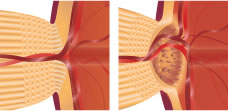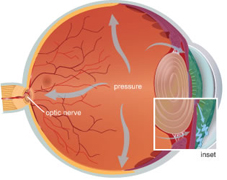

Glaucoma
Glaucoma is the name of a group of eye conditions which damage sight due to raised pressure within the eye. The most common form of glaucoma is 'open angle glaucoma'. About 5% of people over the age of 65 develop glaucoma, but early detection and proper treatment can satisfactorily prevent blindness. Less common is ‘closed angle glaucoma’ which affects the vision more quickly and can be very painful.
Pressure inside the eye is required to keep the eye inflated like a football. Fluids within the eye are produced at the ciliary body, flow around the anterior chamber, and drain through the angle back into the blood stream. A slight restriction at the angle causes a back pressure and this is the pressure the eye needs to sustain its shape. In glaucoma too much fluid is produced or its outflow is restricted so the pressure rises. The rise in pressure is small and gradual and no pain or blurred vision results. Gradually the pressure attacks the small blood vessels which feed the optic nerve head and in turn the nerves which conduct the sight to the brain are destroyed and loss of vision results. It is the longest nerves which are effected first and these control the peripheral vision and losses here are not easily noticed by the person until too late. The result of untreated glaucoma is tunnel vision.
How do you get glaucoma?
Glaucoma is not a condition that is contagious. It is as if the eye itself has a design fault which is not apparent until later in life. About 2 percent of people are affected but this is much higher if a close relative has glaucoma; the 'design fault' can be hereditary.
The role of the optician
Glaucoma is asymptomatic in its early stages and a lot of vision can be lost gradually if undetected. The optician can see these changes looking into the eye. His findings can be verified by measuring the eye pressure (tonometry) and visual field testing.
Curing glaucoma?
No sight already lost can be restored but further losses can be avoided relatively easily. Eye drops which reduce the production of the pressure fluids or open up the drainage channels can be prescribed. Surgery may be considered; today this has been made simpler by lasers.
Avoiding glaucoma
Vision losses may not be rapid so regular eye tests annually are sufficient for people over 40 years, especially if you have relatives with this condition. Inform your optician of any such history. As you can see, today's optician requires little response to obtain valuable results from the uncooperative patient, whether this is for spectacles, eye health or general health care. If you have residents of this type please do not hesitate to contact The Outside Clinic to discuss your particular requirement.
Remember, vision loss through glaucoma is permanent but easily avoided, and can be discussed with your visiting optician.
Eye Health
- Why Sight Tests Are Important
- Glaucoma
- Cataracts
- Macular Degeneration
- Diabetic Retinopathy
- Low Vision Aids
- Spectacles
- Suitable Frames
- Smoking
- Nutrition
(coming soon)


